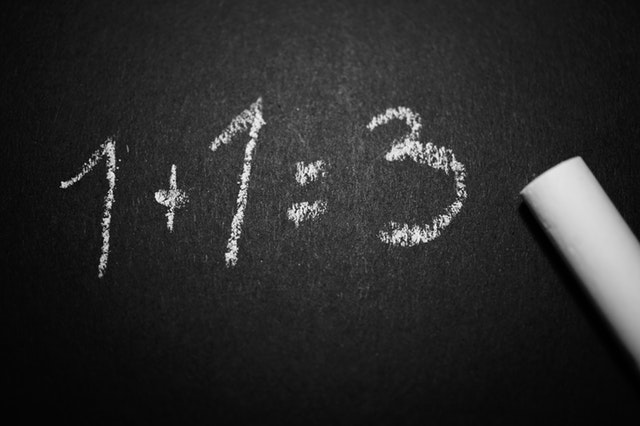Dyscalculia, in broad terms, is a life-long learning disability about numbers and arithmetic skills. It is sometimes confused with math anxiety, which has a different pathology, but which often presents in similar ways. This article deals mostly with ‘developmental dyscalculia’, which is distinguishable from ‘acquired dyscalculia’ in that the latter is as a result of stroke or brain injury.
Some individuals have difficulty acquiring or mastering cognitive abilities that may affect their life in an observable way. This includes dyscalculia (from Greek: dus- “ill”, kalos “beauty” and -λογία “-logy”; see also chrono-, para-, hyper-) and approximately 10% of all mathematical disabilities fall under this category.

Check out [easyazon_link identifier=”1473974267″ locale=”US” tag=”descofthein0a-20″]The Dyscalculia Toolkit: Supporting Learning Difficulties in Maths[/easyazon_link] for a full-on, deep dive into the topic.
Switch to the top-rated therapy platform.
Definition
Diagnostics and comprehensive definitions of dyscalculia are still somewhat confusing. The term was first used in an advertisement in the New York Times in 1968, but Czech researcher Kosc is generally credited for coining ‘developmental dyscalculia’ in 1974. He noted it as “…clearly (distinguishable) from other forms of disturbed mathematical abilities”.
Sometimes called ‘math dyslexia’ or ‘number dyslexia’, the British Dyslexia Association characterizes dyscalculia as the ‘inability to learn basic arithmetic facts, numerical process magnitude, and perform accurate and fluent calculations’. The ‘numerical magnitude’ of an object is its non-verbal numerical representation. Dirt, for instance, doesn’t have numerical magnitude, as one cannot quantify ‘two dirts’.
According to Schulte-Körne, the DSM-IV and V classify dyscalculia as a ‘mathematics disorder’ or learning disorder, with impairment in four sub skills – number sense, memorization of arithmetic facts, accurate or fluent calculation, and accurate math reasoning.
Dyscalculia is not usually associated with low intelligence. This means that an individual (child or adult) who is otherwise intelligent or competent in other learning areas, truly battles with numbers, mathematics and arithmetic. Also, there appears to be a large overlap with other learning disabilities or impairments, which makes dyscalculia a difficult disorder to diagnose.
Classification of Symptoms
Kosc identified six different classifications for the disorder, where students present with problems and difficulties in the following areas:
- Verbal dyscalculia – naming specific amounts, e.g. ‘three oranges’. Later research calls it a lack of number sense or difficulty in understanding quantity.
- Prognostic dyscalculia – manipulating objects mathematically, e.g. making comparisons to determine which is smaller or larger, less or more etc.
- Ideognostical dyscalculia – understanding mathematical and arithmetic concepts and relationships.
- Lexical dyscalculia – reading mathematical symbols, such as operational signs (+, -, <, > etc) and numbers.
- Graphical dyscalculia – writing mathematical symbols such as operational signs (+, -, <, > etc) and numbers.
- Operational dyscalculia – performing arithmetic and mathematical calculations.
Though these findings were not independently verified, Kosc’s classifications nevertheless offer a good basis for understanding the general symptoms of dyscalculia. For the purpose of further clarification, following is a list of general or readily observable symptoms and manifestations of the disorder.

Early Signs of Dyscalculia
Parents and teachers can be extremely important in spotting warning signs of potential developmental problems. Vigilant adults can help detect problems with numbers at an early stage.
Anxiety of math lessons or math teachers
Children suffering from dyscalculia may act up or behave irrationally when it’s time for math class in school, or at home when it’s time for math homework. They might be scared of their math teacher, who is otherwise popular with the other children.
Counting on their fingers
Long after their peers have moved on to counting in their heads, the child may still be using fingers for simple calculations.
Inability to memorize numbers and facts
A substandard working memory can prevent children from remembering numbers and calculating solutions to simple problems.
Not making connections between numbers and quantities
An inability to connect the concept of a number to an actual quantity (eg. when a parent says two apples, but the child can not choose the picture of two apples despite knowing the words).
Not understanding numerical symbols
Most children quickly grasp plus (+) and minus (-) signs’ meaning. A child with dyscalculia may still be struggling with these basic signs while their class has moved on to learning multiplication (x) and division (÷) symbols.
Other and Associated Symptoms
According to the British Dyslexia Association (BDA) and others, dyscalculic children and adults can also present with:
- difficulty counting backward;
- difficulty remembering basic mathematical facts, even after many hours of practice and/or rote learning;
- difficulty in understanding place value and the role of zero in the Arabic/Hindu number system;
- difficulty ascertaining whether or not answers are right or nearly right;
- slow to perform calculations;
- difficulty imagining a mental number line;
- particular difficulty with subtraction, with addition often as the default operation;
- great anxiety when dealing with mathematics;
- difficulty reading or dyslexia;
- attentional difficulties;
- problems with drawing, visualization and remembering understanding time and direction;
- poor coordination of movement (dyspraxia).
It’s important to note that reversing numbers is not a symptom of dyscalculia. It is usually a normal developmental stage for children, and no cause for alarm. The same goes for remembering names – no evidence suggests that dyscalculia is related to long-term verbal memory.
Dyscalculia and ADHD
Students with ADHD are over 30% more likely to have problems with Math, and children with a math learning disability are 25% more likely to have ADHD. The two problems need to be dealt with separately.
ADHD children get used to external stimuli extremely quickly, so the mind struggles to concentrate through repetitive tasks – like multiplication tables, for example. Kids with ADHD may be better off not repeating and practicing math facts too often. This sounds counterintuitive; however, initially, their brain sees the memorization as new and challenging and becomes more inaccurate and bored as the practice continues.
Dyscalculia and Dyslexia
Dyslexia also tends to present itself alongside dyscalculia, with some estimates suggesting its presence in as many as 70% to 80% of all cases. Many of the causes of dyscalculia (poor working memory, slow processing speeds) are common with dyslexia. It’s very tempting for teachers and parents to focus on language and speech problems, however math is, of course a critical skill, as our society relies even further on quantitative information.
Dyscalculia Tests for Adults and Children
If a child or adult has trouble with math, it’s important to establish if dyscalculia is the cause or whether it can be attributed to another problem such as ADHD or a memory disorder.
Testing for dyscalculia evaluates various maths skills including mental computation, math fluency, and quantitative reasoning. A thorough math and dyscalculia test can highlight errors where the dyscalculic is struggling.
Some common tests for diagnosing dyscalculia in children include:
- Counting dots, counting backwards, or counting objects: when observed by a trained professional these exercises can reveal how the child’s brain processes and groups numbers.
- Observation: A doctor will most likely want to observe your child in ‘every-day’ settings, including observing your child at school or playing at home.
- Drawing shapes: This assesses the child’s visual and spatial awareness by identifying if shapes can be redrawn from memory. Poor performance in this area could be affecting ability in overall math skills.
Diagnostic tests for dyscalculia in adults follow similar principles, although they are often completed using computer-based or online assessment alongside observation at home or in the workplace.
It may take several weeks to get the results of these tests. A doctor will evaluate these tests alongside other kinds of intelligence tests and provide you with an overall report.
While it’s always recommended that you seek the opinion of a qualified professional, online dyscalculia quizzes that screen for symptoms and provide results can act as a starting point for a discussion with your doctor.
Causes
The prevalent theory is that dyscalculia is a neurological disorder. However, according to New Zealand-based dyscalculia and mathematical cognition researcher Dr Anna Wilson, research into the neurological causes of dyscalculia is “very much in its infancy.” She states that most dyscalculia research has been done in special populations such as people with Turner’s syndrome, fetal alcohol syndrome, or those born with a low birth weight. These children all present with some form of brain damage. Some evidence suggests that dyscalculic children, though not presenting with any other disorder, show the same limited brain activity in the frontal and parietal areas of the brain. These areas are generally associated with mathematical cognition. Wilson argues that both genetic and environmental factors and the interaction of the two are possible root causes. She says: “The cause for one individual may not be the same as for another, and in many cases, it may not be obvious.” More research is clearly needed.
Prevalence
Research is sketchy at best, but at the 2010 International Conference on [easyazon_link identifier=”1564843890″ locale=”US” tag=”descofthein0a-20″]Mathematics Education Research[/easyazon_link], evidence was presented that proved the prevalence of dyscalculia to be a low 2% of the general population. This is because previous figures generally included “a significant proportion of pupils with what are better called ‘learned difficulties’”, according to the author. Further and updated research is needed.
Switch to the top-rated therapy platform.
Treatment
There is no medical treatment for dyscalculia or any proven and 100% efficacy method. However, that’s not to say that nothing can be done to help.
Dr Wilson suggests that dyscalculic children should receive remedial or specialized assistance as early as possible in their schooling careers. If specialist intervention is impossible, she makes an excellent database of resources available for parents and educators. She notes that good remedial teachers and parents are likely to research, problem-solve, and personalize or individualize assisting methods to help the dyscalculic. She encourages parents and teachers to not stop trying, even in the face of apparent failure.
“The important thing is for neither parents nor children to give up. (The problems) can be overcome, and it is worth it. Do keep evaluating whether you think the current approach is good, and don’t hesitate to try a different person or ask for a second opinion,” she urges. As said, there is no sure-fire umbrella treatment available yet.
The BDA also published a list of resources for download. Some of the items are UK-based, but the list of [easyazon_link identifier=”147397500X” locale=”US” tag=”descofthein0a-20″]available books[/easyazon_link] on the topic should be helpful across borders.
Understood, a US-based organization whose mission is to help parents with children struggling with learning difficulties, suggests multi-sensory techniques for teaching math, using sight, hearing, touch and movement to better understand what numbers and symbols represent. On their site, they also make recommendations for in-class support by teachers.
Assistive technology is also popular in schools, with many options. Understood offers a good list of options for assistance with math, many of them not costly. Teaching applications for devices abound, but the best policy would probably be thorough investigation and caution when acquiring these. Wilson lists the following to look out for when considering an a software application:
- There is no miracle or instant cure for dyscalculia – don’t believe an advertisement that promises such.
- Be suspicious of very high prices. Do not be fooled by the notion that ‘Expensive’ necessarily equals ‘Effective’.
- Be suspicious of ‘special methods’ that have little to do with math. “It is a fundamental psychological principle that the less specific the training is, the less it works”, says Wilson.
- Research if the advertiser claims the app is ‘research based’ or ‘proven in research’. If a solid research foundation for these claims is unavailable or cannot be found, don’t buy.
- Be suspicious when a large investment is required without a chance to cancel or pull out of the transaction.
Dyscalculia is a seriously impairing disorder, but it need not be a life sentence for any person. Famous singer Cher suffers from dyscalculia, and look where she landed.
Conclusion: How much do we know about Dyscalculia?
Several factors could contribute to this learning disorder, including neurological impairment and genetic predisposition. In addition, the environment in which children were raised may have contributed.
According to the theories of developmental psychology, dyscalculia is not only a ‘mathematical disability’. It should be regarded as a psychological disorder rooted in some fundamental aspects of how the human brain processes information. In other words, it is not just about numbers.
The debate between dyscalculia and math disabilities is whether they are genetic or the result of some form of brain that occurred after birth.
This is because it is more difficult to treat genetic conditions, while brain damage and other related injuries can be cured by surgery.
Dyscalculia can affect both the right and left sides of the brain, while math disabilities are generally one-sided, so the dyscalculia happens more often or entirely from genetic reasons.
Dyscalculia has been with humans since their existence, while math disabilities are very recent.
The concept of dyscalculia is not very well defined. There are several forms: the first form is that in which there has been an actual injury to the brain caused by trauma or illness; this results in damage to a specific part of the brain, causing difficulties with certain mathematical functions.
Another form of the condition is caused by psychological factors and/or a lack of education. It can be said, however, that this particular factor does not really make up a part of true dyscalculia. As for the last possibility – namely that there has been no injury to the brain in any way whatsoever, and yet certain mathematical functions are still affected or present in an unusual manner- this is most common.
In the case of physical trauma to the brain, while some parts of the brain are damaged, there may still be other areas remaining intact that allow for normal functioning. If this is the case, then a person can lead a fairly good and normal life.
In the case of psychological factors and/or a lack of education, such a person can also lead a good life. It is very important to realize that in some cases other mental functions are affected by this problem.
Featured review — Top Six Pen Scanners to Take You From Primers to Proust
- Claustrophobia: The Fear of Restricted & Confined Spaces - July 25, 2024
- Dyscalculia: Causes, Symptoms, and Prevalence - December 3, 2019
- Nosophobia: The Fear of Illness & Disease - April 17, 2019
